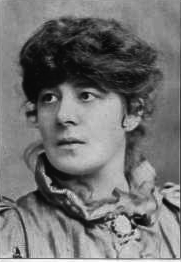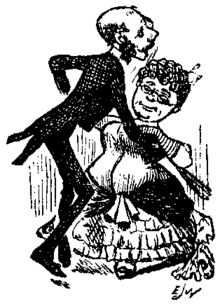Arabella Kenealy
Arabella Kenealy (11 April 1859 – 18 November 1938) was a British writer, physician and eugenicist. She thought that every part of the cosmos, each hemisphere and each half of the human body had a more female side. She was concerned that women taking exercise might reduce their ability to be the "mother of men".
Arabella Kenealy | |
|---|---|
 Dr Kenealy | |
| Born | 11 April 1859 Portslade |
| Died | 18 November 1938 Marylebone |
| Nationality | British |
| Subject | race improvement |
Life
Kenealy was born in Portslade in 1859. She was the second of the eleven children of Elizabeth and Edward Kenealy.[1] Her siblings included Alexander who became the editor of the Daily Mirror and her sister Annesley who was also a writer.[2] Her father became a notorious Queens Counsel barrister after his unusual behaviour in the Tichborne Case.[1] She became a doctor at the London School of Medicine for Women after a home education. Keneally started to practice medicine in 1888 but diphtheria obliged her to give up medicine in 1894.[3]
In 1893 she wrote Dr Janet of Harley Street[4] which was successful. Its lead character is a female physician who adopts a younger woman who is escaping from an unhappy marriage.[1] In 1896 she published a short Gothic story called "A Beautiful Vampire".[5][6]

1895 saw her letter to the British Medical Journal published. In the letter she reported that she had refused treatment to a pregnant woman with syphilis after seeing that she already had a child with congenital syphilis. Kenealy, like other doctors, found the effects of syphilis troubling. This was the first account of a woman doctor advising on the treatment of a sexually transmitted disease. Kenealy was a eugenicist and she asks BMJ readers to advise on whether failing to assist the "birth of such a child as laid its dull misshapen head against my knee that morning" was a good course of action.[7] Her question drew mixed responses and some medical men attacked her approach.
Her book Feminism and Sex Extinction (1920), as its title suggests, focused on what she perceived as the harmful effects of the women’s rights movement.
Kenealy was intrigued by the effect that the earth's rotation might have on evolution. Her 1934 book explained "the phenomenon of sex: its origin and development and its significance in the evolutionary process."[8] She believed that people from the northern hemisphere were more male. Moreover, she wrote that every part of the cosmos had male and female aspects; this included people who had more maleness on the right side of their bodies.[9] Women were told to take exercise but they were warned that too much exercise could make women's bodies to lose their natural abilities to be the "mother of men".[10]
Men were also criticised by Kenealy for spending too much time dancing. She considered that they should spend more time thinking about marriage. This view was parodied in the magazine Punch.[11][12]
Death and legacy
She died in Marylebone in 1938 and was buried at St Helen's Church, Hangleton.[3]
Kenealy was one of the people chosen by Martin Gardner in his book Fads and Fallacies in the Name of Science.[9]
References
- Angelique Richardson, ‘Kenealy, Arabella Madonna (1859–1938)’, Oxford Dictionary of National Biography, Oxford University Press, 2004; online edn, May 2015 accessed 15 April 2017
- Arabella Kenally, Goodreads, Retrieved 15 April 2017
- Arabella Kenealy Archived 6 October 2016 at the Wayback Machine, Nipissingu.ca, Retrieved 15 April 2017
- Kenealy, Arabella (1894). Dr Janet of Harley Street (2nd ed.). London: Digby, Long & Co.
- Swenson, Kristine (1 March 2003). "The menopausal vampire: arabella kenealy and the boundaries of true womanhood". Women's Writing. 10 (1): 27–46. doi:10.1080/09699080300200257. ISSN 0969-9082.
- Tomaiuolo, Saverio (2010). In Lady Audley's Shadow: Mary Elizabeth Braddon and Victorian Literary Genres. Edinburgh University Press. p. 207. ISBN 9780748686940.
- Meehan, Dr Ciara (1 September 2014). "'Such mental suffering and such misery': Reproductive complications resulting from syphilis and gonorrhoea, 1880-1914". Perceptions of Pregnancy. Retrieved 17 April 2017.
- Kenealy, Arabella (1 January 1934). The human gyroscope: a consideration of the gyroscopic rotation of earth as mechanism of the evolution of terrestrial living forms: explaining the phenomenon of sex: its origin and development and its significance in the evolutionary process. J. Bale, Sons & Danielsson, ltd.
- Martin Gardner (4 May 2012). Fads and Fallacies in the Name of Science. Courier Corporation. pp. 243–. ISBN 978-0-486-13162-7.
- Kathleen McCrone (24 April 2014). Sport and the Physical Emancipation of English Women (RLE Sports Studies): 1870-1914. Routledge. p. 259. ISBN 978-1-317-67964-6.
- Punch, or The London Charivari, 21 November 1891, Punch, volume 101, Retrieved 15 April 2017
- Kenealy, Arabella (1891). "A New View of the Surplus of Women". The Westminster Review. 136: 465–475.